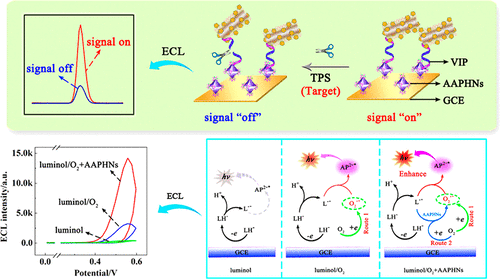当前位置:
X-MOL 学术
›
Anal. Chem.
›
论文详情
Our official English website, www.x-mol.net, welcomes your
feedback! (Note: you will need to create a separate account there.)
Electrochemiluminescence Peptide-Based Biosensor with Hetero-Nanostructures as Coreaction Accelerator for the Ultrasensitive Determination of Tryptase
Analytical Chemistry ( IF 6.7 ) Pub Date : 2018-01-16 00:00:00 , DOI: 10.1021/acs.analchem.7b04631 Fang-Fang Wu 1 , Ying Zhou 1 , Han Zhang 1 , Ruo Yuan 1 , Ya-Qin Chai 1
Analytical Chemistry ( IF 6.7 ) Pub Date : 2018-01-16 00:00:00 , DOI: 10.1021/acs.analchem.7b04631 Fang-Fang Wu 1 , Ying Zhou 1 , Han Zhang 1 , Ruo Yuan 1 , Ya-Qin Chai 1
Affiliation

|
In this work, a luminol-centric biosensor was constructed for the ultrasensitive detection of tryptase (TPS) combining dissolved O2 as the endogenous coreactant and Au–Ag–Pt heteronanostructures (AAPHNs) as coreaction accelerator. Dissolved O2 could rapidly generate superoxide anion radical (O2•–) with the catalysis of AAPHNs to in situ react with luminol anion radical (L•–) to generate excited-state species 3-aminophthalate (AP2–*) for emitting ECL signal, resulting in a remarkable “single on” state. In order to further improve the sensitivity of the sensor, we employed self-assembled DNA nanotubes (DNANTs) as a carrier to immobilize the luminophore of doxorubicin-luminol (Dox-Lu) complex. In this assay system, target tryptase could directly induce the cleavage of vasoactive intestinal peptide (VIP), which caused the ECL probe of DNANTs-Dox-Lu releasing from the electrode surface to obtain a significant “signal off” state. By changing the signal from “on” to “off”, the proposed ECL peptide-based biosensor for TPS detection achieved a dynamic concentration range (2.5 pg/mL–200 ng/mL) with an extremely low detection limit of 0.81 pg/mL. This work presented a new signal amplification method for the construction of the sensor based on the luminol-dissolved O2 ECL system.
中文翻译:

基于电化学发光肽的生物传感器,具有杂合纳米结构作为共作用促进剂,用于超灵敏测定类胰蛋白酶
在这项工作中,构建了以鲁米诺为中心的生物传感器,用于结合溶解的O 2作为内源性共活化剂和Au-Ag-Pt异质纳米结构(AAPHNs)作为共作用促进剂,对胰蛋白酶(TPS)进行超灵敏检测。溶解的O 2可以通过AAPHNs的催化而迅速生成超氧阴离子自由基(O 2 •–)与鲁米诺阴离子自由基(L •–)反应生成激发态物质3-氨基邻苯二甲酸酯(AP 2– *)。)以发出ECL信号,从而产生明显的“单开”状态。为了进一步提高传感器的灵敏度,我们采用了自组装的DNA纳米管(DNANTs)作为载体来固定阿霉素-鲁米诺(Dox-Lu)复合物的发光体。在该测定系统中,目标类胰蛋白酶可以直接诱导血管活性肠肽(VIP)的裂解,从而导致DNANTs-Dox-Lu的ECL探针从电极表面释放,从而获得明显的“信号关闭”状态。通过将信号从“开”更改为“关”,建议的基于ECL肽的TPS检测生物传感器实现了动态浓度范围(2.5 pg / mL–200 ng / mL),极低的检测限0.81 pg / mL 。这项工作提出了一种新的信号放大方法,该方法用于基于溶解有鲁米诺的O的传感器构造2 ECL系统。
更新日期:2018-01-16
中文翻译:

基于电化学发光肽的生物传感器,具有杂合纳米结构作为共作用促进剂,用于超灵敏测定类胰蛋白酶
在这项工作中,构建了以鲁米诺为中心的生物传感器,用于结合溶解的O 2作为内源性共活化剂和Au-Ag-Pt异质纳米结构(AAPHNs)作为共作用促进剂,对胰蛋白酶(TPS)进行超灵敏检测。溶解的O 2可以通过AAPHNs的催化而迅速生成超氧阴离子自由基(O 2 •–)与鲁米诺阴离子自由基(L •–)反应生成激发态物质3-氨基邻苯二甲酸酯(AP 2– *)。)以发出ECL信号,从而产生明显的“单开”状态。为了进一步提高传感器的灵敏度,我们采用了自组装的DNA纳米管(DNANTs)作为载体来固定阿霉素-鲁米诺(Dox-Lu)复合物的发光体。在该测定系统中,目标类胰蛋白酶可以直接诱导血管活性肠肽(VIP)的裂解,从而导致DNANTs-Dox-Lu的ECL探针从电极表面释放,从而获得明显的“信号关闭”状态。通过将信号从“开”更改为“关”,建议的基于ECL肽的TPS检测生物传感器实现了动态浓度范围(2.5 pg / mL–200 ng / mL),极低的检测限0.81 pg / mL 。这项工作提出了一种新的信号放大方法,该方法用于基于溶解有鲁米诺的O的传感器构造2 ECL系统。











































 京公网安备 11010802027423号
京公网安备 11010802027423号